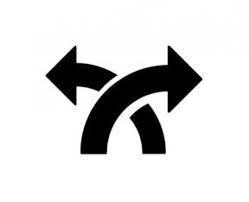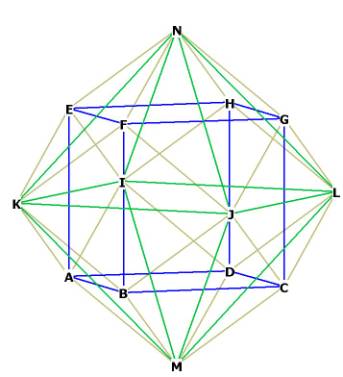|
(2017
premidterm assignment) Model Student Midterm answers 2017 (Index) Essay 1: Compare, contrast, and evaluate Narratives of the Future |
 |
Clark
Omo
The Future Duo: The Links Between the Two Narratives
At
the start of this course, I was introduced to the two narratives of Literature
concerning the Future: Evolution and Creation/Apocalyptic. Both narratives, in
different forms and fashions, suffuse a great deal of the literature we have so
far studied in this class. Both narratives overhang and directly motivate the
storylines of this genre. For Creation/Apocalyptic, we are given a definite
beginning and a foreseeable ending. For Evolution, we are also given a somewhat
unspecific beginning (which, is at times, shrouded by speculation) and the
Apocalypse is supplemented by a continuous chain of evolutionary events that
have either furthered man’s progress (or the reverse) in terms of technology,
government, biology, etc. Both narratives, interestingly, coincide on a single
point: they both promote an anxiety toward what lies ahead. This point is the
driving force of both narratives, as it serves as the vector through which the
readers can explore the possibilities, both optimistic and frightening, that lie
ahead.
For
the Creation/Apocalyptic, we were first introduced to this narrative in the
story of Genesis from the Bible, along with its Apocalyptic counterpart,
Revelation. As Genesis begins with the infamous “In the beginning, God created
the heavens and the earth.” (Genesis 1:1, NIV), we are immediately given a
framework from which the Creation narrative grew. God has created the universe,
and thus begun a cycle, for as implied with every beginning, there must also be
an end. That end comes in Revelation, where God unleashes his judgment upon the
earth and its inhabitants. And this narrative is followed closely in Octavia
Butler’s The Parable of the Sower. At
the beginning of this novel, as was pointed out in class, Lauren, the
protagonist, begins her journey in a walled community, seemingly safe from the
dangers of the world that lie outside the barriers. This is much like the Garden
of Eden, for Eden was a haven: a sanctuary that preserved innocence and kept its
inhabitants safe, much like that of Lauren’s town. But, as the serpent crept
into the Garden, danger and destruction finally violated Lauren’s home. And, so
the Creation, with its initial promises of Edenic peace, came crashing down in a
Revelation-style hail of fire. Throughout the first half of the book, Lauren
constantly voices her concern regarding this eventual destruction of her home.
“It’s getting worse, Dad.” she says on page 66. The anxiety for the future and
the terrors it might bring resonate here in these few words, as they do
throughout the whole of the Creation/Apocalyptic narrative.
A
similar feeling emanates from the Evolution narrative. “Stone Lives” by Paul Di
Filippo represents this well. The titular character, known only as Stone, lives
in world that has evolved (or devolved, depending on you look at it) into a
world run by corporations who have divided the known world into FEZs: Free
Enterprise Zones. Man has also advanced further in technology. Stone, for
instance, begins as a blind man; by the middle of the story, Citrine
Technologies grants him a pair of fully functional, artificial eye replacements
with capabilities that our own eyes can never hope to replicate. But do these
advancements truly represent an overall positive progression for the human race?
That seems to be the question. In his essay, Timothy Morrow notices this
tendency in the Evolution Narrative: “Many Future Narratives actually have the
outer shallower perception of progress, but when truly analyzed, it could be
argued that there is the underlining theme of decline.” Decline underscores this
world without any question; and it seems contradictory. For so much time to have
elapsed where humans can replace entire body parts and organs with more-improved
substitutes, one would think they would have advanced in the area of
humanitarian treatment as well. Zach Thomas notes this when speaking of human
attitude toward change: “Humans accept change as progress or decline.” No matter
the advancement, humanity’s flaws still warp our future’s promises and turn them
into utter nightmares. As Stone profoundly summarizes of the world around him:
“Beautiful, gaudy, exciting at times—but basically unfair” (196). The world has
evolved in some respects, but, to the core, is as unfair as it is now.
Both
the Evolution and Creation/Apocalypse Narratives touch on similar themes. Both
have a starting point and slowly progress with trial and time, and eventually
reach a transforming climax. For Creation, this is the Apocalypse. As outlined
in the Bible, Creation started off good, then worsened as time went along, and
at last reaches the end of its rope with the Apocalypse. For Evolution, things
only have a tendency to get worse (or stay the same) even as they progress. Both
outcomes succeed in evoking questions regarding the end of all. For Creation,
will there be an Apocalypse? For Evolution, will things ever truly progress? The
supposed answers seem to be as numerous as the stars; nonetheless, both
questions represent anxieties toward the future and allow for the exploration of
such fears. And these fears, which permeate Literature of the Future in much the
same way gravity does so for reality, motivate the genre entirely.
 |
 |
 |
